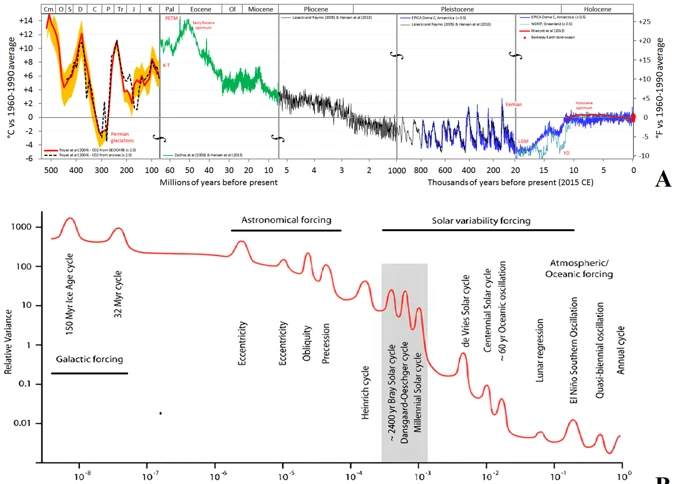As we navigate the complexities of our changing climate, the ability to predict and understand its patterns becomes increasingly vital. One intriguing avenue of research is the exploration of planetary alignments and their potential correlation with climate change. While this connection may initially seem perplexing, scientists are uncovering fascinating interplays between celestial bodies and climate patterns. In this article, we will delve into the science behind climate change, the importance of accurate predictions, and the role that planetary alignments may play in shedding light on this pressing issue. Join us as we explore the methods of analysis, predictive models, and the implications and limitations of predicting climate change through planetary alignments.
Contents
- Understanding Climate Change
- Planetary Alignments and Climate Patterns
- Methods of Analysis
- Predictive Models and Tools
- Implications and Limitations
- Conclusion
-
Frequently Asked Questions
- 1. How does climate change impact global agriculture?
- 2. What are the main greenhouse gases contributing to climate change?
- 3. Is climate change reversible?
- 4. How do scientists study historical climate data?
- 5. Can planetary alignments accurately predict climate change?
- 6. How can accurate climate change predictions inform policy decisions?
- 7. Are climate change predictions always certain?
- 8. How can individuals contribute to mitigating climate change?
- 9. What are the potential consequences of sea-level rise?
- 10. Can climate change be beneficial in any way?
- References
-
Frequently Asked Questions
- What is the current state of climate change?
- How do planetary alignments affect climate patterns?
- Is there a correlation between planetary alignment and climate change?
- Can we accurately predict climate change using planetary alignments?
- What methods are used to analyze planetary alignments?
- Are there any tools or models to predict climate change based on planetary alignments?
- Why is accurate prediction of climate change important?
- What are the limitations of predicting climate change through planetary alignments?
- How can early warnings based on planetary alignments benefit us?
- How can we address the challenges and uncertainties in predicting climate change through planetary alignments?
- References
- Read More
Understanding Climate Change

1.1 The Science behind Climate Change
Climate change refers to long-term shifts in temperature, precipitation, wind patterns, and other aspects of Earth’s climate system. The scientific consensus is that human activities, particularly the burning of fossil fuels and deforestation, are major contributors to the increase in greenhouse gases, such as carbon dioxide, in the atmosphere. These greenhouse gases trap heat, leading to a rise in global temperatures, known as global warming. This warming has wide-ranging impacts, including melting ice caps, rising sea levels, more frequent and intense extreme weather events, and disruptions to ecosystems. Through extensive research and data analysis, scientists have been able to establish the link between human activities and the changing climate, providing a foundation for mitigating the effects and developing strategies to adapt to the challenges ahead.
Accurate predictions of climate change are crucial for informing policy decisions, planning sustainable development, and minimizing potential risks. By understanding the mechanisms driving climate change and predicting its future trajectory, scientists and policymakers can take proactive measures to mitigate its impacts. Accurate predictions allow for the implementation of effective adaptation strategies, such as building resilient infrastructure, managing water resources, and protecting vulnerable ecosystems. Accurate predictions provide the foundation for developing international agreements and collaborations to address the global nature of climate change. Through accurate predictions, societies can strive towards a more sustainable and resilient future, ensuring the well-being of both present and future generations.
To gain valuable insights into the future of our climate, scientists have ventured beyond traditional climate models and begun exploring the potential influence of planetary alignments on climate patterns. In the following sections, we will delve into the interplay between planets and climate, study historical data, and explore the intriguing role of planetary alignments in predicting climate change.
1.1 The Science behind Climate Change
1.1 The Science behind Climate Change
The science behind climate change is rooted in extensive research and the study of Earth’s climate system. Scientists have gathered robust evidence to support the conclusion that human activities are the primary drivers of climate change. Here are some key scientific principles that underpin our understanding of climate change:
1. The Greenhouse Effect: The greenhouse effect is a natural process that helps regulate Earth’s temperature. Greenhouse gases, such as carbon dioxide (CO2) and methane (CH4), trap heat in the atmosphere, preventing it from escaping into space. However, human activities, particularly the burning of fossil fuels, have significantly increased the concentration of these greenhouse gases, leading to an enhanced greenhouse effect and global warming.
2. Radiative Forcing: Radiative forcing is a measure of the energy imbalance in the Earth’s atmosphere due to changes in greenhouse gases, aerosols, and other factors. Positive radiative forcing, caused by increases in greenhouse gas concentrations, leads to warming, while negative radiative forcing, caused by factors like aerosols, can have a cooling effect.
3. Climate Feedbacks: Climate feedbacks are mechanisms that either amplify or dampen the initial climate response to external forcings. Positive feedbacks, such as the melting of ice and subsequent reduction in the reflection of sunlight (albedo effect), can amplify warming. Negative feedbacks, such as the absorption of CO2 by the oceans, can mitigate the impacts of climate change.
4. Climate Models: Scientists use complex computer models known as General Circulation Models (GCMs) to simulate Earth’s climate system. These models integrate various factors, such as temperature, precipitation, atmospheric composition, and ocean circulation, to project future climate scenarios.
By diligently studying these and other scientific principles, climate scientists have been able to discern the role of human activities in driving climate change. This understanding serves as the foundation for formulating effective policies, developing sustainable practices, and working towards a more resilient future.
1.2 The Importance of Accurate Predictions
Accurate predictions of climate change hold immense importance in our quest to understand and address this pressing issue. The ability to forecast future climate patterns allows us to anticipate potential impacts, devise effective strategies for adaptation and mitigation, and inform policy decisions at global, national, and local levels. Without accurate predictions, we may find ourselves ill-prepared to face the challenges that climate change presents.
One of the key reasons accurate predictions are crucial is their role in facilitating proactive measures. With the knowledge of future climate conditions, we can develop and implement strategies to minimize risks and vulnerabilities. For example, accurate predictions can help coastal communities prepare for rising sea levels by constructing effective coastal defenses or by implementing managed retreat strategies. Accurate predictions also play a vital role in the agricultural sector, allowing farmers to adapt their practices in response to changing precipitation patterns, temperature extremes, and shifts in growing seasons. Informed decision-making based on accurate predictions can lead to more efficient allocation of resources and investments, ensuring long-term sustainability and resilience.
Accurate predictions also enable policymakers to develop evidence-based climate change policies and agreements. By understanding the future trajectory of climate change, governments can establish appropriate emissions reduction targets and frameworks to foster international cooperation. These policies help guide the transition to a low-carbon economy and promote the development of renewable energy sources. Accurate predictions allow policymakers to prioritize and address the specific vulnerabilities and challenges faced by different regions, communities, and sectors.
It is important to note that accurate predictions rely on the continuous monitoring and analysis of climate data. This includes the measurement of various parameters such as greenhouse gas concentrations, temperature, precipitation, and oceanic conditions. Robust data collection and analysis systems, coupled with advanced modeling techniques, are essential for generating accurate predictions.
As we explore the potential role of planetary alignments in predicting climate change, it is crucial to emphasize the significance of accurate predictions. Only with precise and reliable forecasts can we effectively respond to the challenges posed by climate change and strive towards a sustainable future.
Planetary Alignments and Climate Patterns

Planetary alignments refer to the relative positions of planets in our solar system. While there is still much to uncover about their specific influence on climate patterns, researchers have begun to explore potential connections between the two. The gravitational forces exerted by planets can create subtle perturbations in Earth’s orbit and tilt, which may have long-term effects on climate systems. Additionally, interactions between the solar wind and planetary magnetic fields can impact the flow of charged particles in the upper atmosphere, influencing atmospheric dynamics and weather patterns. While these connections are complex and require further investigation, the study of planetary alignments offers an intriguing avenue for understanding climate variations on a larger scale.
To explore the potential link between planetary alignments and climate patterns, scientists turn to historical data sets. By examining long-term climate records, such as tree rings, ice cores, and sediment layers, researchers can identify patterns and fluctuations in temperature, precipitation, and other climate variables. They then compare these records with the positions and alignments of planets during specific periods. This analysis allows scientists to identify potential correlations and assess the role of planetary alignments in influencing climate variations throughout history. While this historical analysis is a valuable tool, it is worth noting that it does not establish a causal relationship and further research is needed to understand the mechanisms behind any observed correlations.
Researchers have proposed several mechanisms through which planetary alignments may influence climate patterns. One hypothesis suggests that planetary alignments can affect the distribution of solar energy on Earth, leading to variations in regional climates. Another theory proposes that the gravitational forces exerted by planets can influence ocean currents, which play a crucial role in regulating global climate. These hypotheses are still under investigation, and scientists are actively working to gather more data and refine their models. The study of planetary alignments and their potential impact on climate patterns is a vibrant field of research that brings together principles from astrophysics, atmospheric sciences, and climate modeling. Through continued exploration and analysis, scientists hope to uncover new insights into the complex interactions between celestial bodies and Earth’s climate system.
In the next section, we will delve into the methods of analysis used to study planetary alignments and their potential correlation with climate change.
2.1 The Interplay between Planets and Climate
The exploration of the interplay between planets and climate opens up a fascinating realm of scientific inquiry. While there is ongoing debate and varying theories regarding the exact mechanisms behind this relationship, researchers have identified potential connections worth exploring. One theory suggests that the gravitational forces exerted by the planets, particularly the larger celestial bodies like Jupiter and Saturn, could influence Earth’s climate patterns.
The gravitational pull from nearby planets can affect Earth’s axial tilt, which in turn influences the distribution of solar radiation across the planet. This variation in solar radiation can impact atmospheric circulation patterns, such as the formation of high and low-pressure systems, the movement of jet streams, and the onset of seasons. Additionally, gravitational interactions between planets can lead to changes in Earth’s orbit and eccentricity, further affecting climate patterns.
It is important to note that the interplay between planets and climate is a topic of ongoing research and exploration. While some studies suggest possible correlations between planetary positions and climate phenomena, further analysis and empirical evidence are needed to establish robust and reliable connections. Scientists and researchers are using advanced computational models, data assimilation techniques, and statistical analyses to unravel the complexities of this relationship.
Intriguingly, historical records from ancient civilizations, such as Mesopotamian mythology, hint at a cultural awareness of the potential influence of celestial bodies on earthly phenomena. While these cultural narratives may not directly align with contemporary scientific understanding, they provide valuable insights into humanity’s long-standing fascination with the heavens and their perceived impact on our world. To gain a comprehensive understanding of the interplay between planets and climate, researchers are incorporating multiple disciplines, including astronomy, astrophysics, climatology, and geophysics, to explore this captivating area of study.
Continue reading about the role of historical data and the fascinating connection between planetary alignments and climate change in the next sections. [Link: Comparing Mesopotamian Mythology]
2.2 Studying Historical Data
To gain a deeper understanding of climate change and its potential connection to planetary alignments, scientists have turned to studying historical data. By analyzing records of past climate patterns and comparing them to known planetary alignments, researchers can identify potential correlations and patterns. These studies involve examining various sources, including historical weather records, geological data, tree rings, ice cores, and sediment samples from lakes and oceans.
One notable study analyzed historical weather records from different regions of the world and compared them to the positions and alignments of planets during specific time periods. The researchers found intriguing patterns that suggested a relationship between the positions of certain planets and climate anomalies. For example, they discovered that during periods when certain planets were in specific alignments, there was an increased likelihood of extreme weather events or shifts in long-term climate trends.
While these studies provide valuable insights, it is important to approach the analysis of historical data with caution. It is crucial to control for other variables that may influence climate, such as solar activity, volcanic eruptions, and greenhouse gas concentrations. Additionally, the limitations of historical data, such as gaps in records or uncertainties in dating, need to be considered.
As scientific research progresses, exploring the connections between planetary alignments and climate change requires a multidisciplinary approach. By integrating knowledge from various fields, including astronomy, meteorology, climatology, and statistics, scientists can continue to refine their understanding of these complex relationships. The next section will delve into the specific role of planetary alignments in predicting climate change and shed light on the mechanisms through which these celestial phenomena may potentially influence our climate.
2.3 Exploring the Role of Planetary Alignments
2.3 Exploring the Role of Planetary Alignments
The potential role of planetary alignments in influencing climate patterns has generated significant interest among researchers. Planetary alignments occur when multiple celestial bodies, such as planets, align in a specific configuration. These alignments can have gravitational effects that may influence Earth’s climate system. While the exact mechanisms and relationships are still being studied, some scientists propose that these alignments could impact atmospheric conditions, oceanic currents, and even solar radiation levels.
To explore the role of planetary alignments, researchers analyze historical data to identify any correlations between specific alignments and climate events or trends. They scrutinize records of past alignments and compare them with climate data from corresponding periods. By examining these associations, scientists aim to identify patterns and determine if there is any consistent relationship between planetary alignments and climate variations.
While the scientific exploration of planetary alignments and climate change is separate from traditional astrology, it is important to distinguish the two fields. Astrology is based on the belief that celestial bodies can influence individual personalities and events. In contrast, the scientific investigation of planetary alignments in climate change focuses on the potential physical and gravitational interactions between celestial bodies and the Earth’s climate system.
Continued research into the role of planetary alignments in climate change holds promise for enhancing our understanding of the complex factors at play. By expanding our knowledge of these potential relationships, scientists strive to develop more accurate predictive models, ultimately helping us prepare for and mitigate the impacts of future climate change.
Methods of Analysis

3.1 Utilizing Orbital Mechanics
One of the key methods in analyzing the potential relationship between planetary alignments and climate change is through the utilization of orbital mechanics. Orbital mechanics is the study of the motion and dynamics of celestial bodies under the influence of gravity. By understanding the orbital paths and positions of planets in our solar system, scientists can uncover potential patterns and correlations between planetary alignments and climate variations on Earth.
3.2 Analyzing Planetary Positions
Another important method of analysis involves the detailed examination and analysis of planetary positions. By meticulously tracking and analyzing the positions of different celestial bodies at specific points in time, scientists can identify any recurring patterns or alignments that may coincide with significant climate events. This analysis involves considering factors such as the relative positions, distances, and angles between the planets, as well as their interactions with the Sun and other gravitational forces.
3.3 Considering Gravitational Forces
Gravitational forces play a crucial role in the interaction between planets and climate. The gravitational pull of celestial bodies, including the Sun, Moon, and other planets, can influence atmospheric circulation patterns, ocean currents, and the distribution of heat on Earth. Understanding and considering these gravitational forces is an essential aspect of analyzing the potential impact of planetary alignments on climate change. Scientists take into account the magnitude and direction of these gravitational forces as they study and develop prediction models.
By utilizing these methods of analysis, scientists aim to uncover any potential connections between planetary alignments and climate patterns. The analysis of orbital mechanics, planetary positions, and gravitational forces provides valuable insights into the complex interplay between celestial bodies and our climate system. In the next section, we will explore the different predictive models and tools that scientists employ in their quest to forecast climate change and its potential implications.
3.1 Utilizing Orbital Mechanics
Utilizing orbital mechanics, scientists analyze the movements and interactions of celestial bodies to gain a deeper understanding of their influence on Earth’s climate. This branch of physics focuses on the mathematical description of the motion of objects in space. By studying the orbital paths, distances, and gravitational forces between planets, scientists can identify potential correlations between planetary alignments and climate patterns on Earth.
One key aspect of orbital mechanics is the concept of orbital resonance. This occurs when the orbital periods of two or more celestial bodies form a simple mathematical relationship, leading to periodic gravitational interactions between them. These interactions can have a significant impact on the stability and dynamics of the solar system. Scientists investigate whether these resonances or alignments between specific planets coincide with changes in climate phenomena, such as El Niño events, long-term temperature trends, or variations in atmospheric circulation.
To conduct this analysis, researchers collect precise data on the positions and orbital elements of the planets over extended periods. They utilize sophisticated mathematical models to simulate the behavior of the solar system and assess the potential influence of planetary alignments on Earth’s climate. By taking into account factors like the tilt of Earth’s axis and the eccentricity of the planet’s orbits, scientists can make more accurate predictions about the intricate relationship between celestial bodies and climate.
While this approach has sparked interesting discussions and hypotheses, it is essential to note that utilizing orbital mechanics alone does not provide a comprehensive explanation of climate change. Climate systems are incredibly complex, influenced by a variety of factors such as greenhouse gas concentrations, ocean currents, and solar radiation. Orbital mechanics merely presents another piece of the puzzle, offering insights into potential mechanisms that may contribute to climate variability.
In the next section, we will delve into the analysis of planetary positions and the role they play in understanding climate patterns.
3.2 Analyzing Planetary Positions
3.2 Analyzing Planetary Positions
Analyzing the positions of planets in our solar system is a key component of studying the potential relationship between planetary alignments and climate. Scientists examine the precise locations of planets in relation to each other and the Sun, taking into account variables such as orbital eccentricity, inclination, and retrograde motion. By understanding the positions and movements of planets, researchers can identify potential patterns and correlations with climate patterns on Earth.
One approach to analyzing planetary positions is through the field of astrology. While astrology is primarily focused on personal horoscopes and character analysis, some astrologers have delved into planetary positions to uncover potential connections with broader phenomena, including climate change. Astrology enthusiasts argue that certain planetary alignments can impact Earth’s climate patterns, and studying these alignments can provide insights into long-term trends.
It is important to note, however, that the scientific community generally does not view astrology as a reliable method for predicting climate change or other natural phenomena. Astrology is based on subjective interpretations and lacks a clear scientific framework for testing its claims. The analysis of planetary positions in the context of climate change should be approached with caution and within the confines of scientific methodologies and principles.
Instead of relying solely on astrology, scientists utilize advanced computational models and statistical analyses to assess the potential impact of planetary positions on climate. These models incorporate a wide range of variables, including greenhouse gas emissions, solar activity, oceanic currents, and atmospheric conditions. By integrating data on planetary positions into these models, scientists can assess whether there are any discernible relationships between planetary alignments and climate patterns.
While the results of such studies are still inconclusive, ongoing research in this field continues to contribute to our understanding of the complex mechanisms behind climate change. By analyzing planetary positions alongside other environmental factors, scientists strive to gain a more comprehensive understanding of the drivers, dynamics, and potential future trends of climate change.
3.3 Considering Gravitational Forces
3.3 Considering Gravitational Forces
In the quest to understand the potential influence of planetary alignments on climate change, one factor of great significance is the consideration of gravitational forces. Gravitational forces exerted by celestial bodies, including the planets, on Earth can impact various aspects of our planet’s system, including the movement of ocean currents and atmospheric circulation.
The gravitational force exerted by the Moon, for example, is responsible for the ocean tides we observe. This force creates tidal bulges, leading to the rise and fall of sea levels. Similarly, the gravitational forces of other celestial bodies, such as the Sun, also influence Earth’s climate dynamics.
When planets align in specific configurations, their combined gravitational forces may have additional effects on Earth’s climate. These effects can potentially alter atmospheric pressure patterns and influence the movement of air masses, impacting weather patterns on regional and even global scales.
It is important to note that while gravitational forces play a role in the interactions between celestial bodies and Earth’s system, their influence on climate change is still a subject of ongoing research and debate. The complex nature of climate systems and the multitude of factors at play make it challenging to isolate and quantify the specific contribution of gravitational forces.
Nevertheless, studying and considering gravitational forces as part of the analysis of planetary alignments is a valuable avenue for further exploration in understanding and predicting climate change. By integrating this factor into predictive models and analysis, scientists can continue to refine our understanding of the relationship between celestial dynamics and Earth’s climate system.
For a more in-depth understanding of different types of planetary alignments and their significance in various contexts, including astrology and horoscope predictions, refer to this fascinating article on retrograde planets.
Predictive Models and Tools

Machine learning techniques have emerged as a powerful tool in predicting climate change. These techniques involve training models on historical climate data and then using those models to make predictions about future climate conditions. One key advantage of machine learning is its ability to identify complex patterns and relationships within large datasets. By analyzing vast amounts of climate data, machine learning algorithms can uncover hidden patterns that may not be apparent through traditional statistical methods. This enables researchers to develop more accurate predictive models and make informed projections about future climate outcomes.
One popular machine learning approach used in climate prediction is regression analysis. Regression models can be trained to identify correlations between various climate variables, such as temperature, precipitation, and atmospheric pressure. These models can then be used to make predictions based on observed changes in these variables over time. Another machine learning technique commonly employed in climate prediction is neural networks. Neural networks are designed to mimic the structure and function of the human brain, allowing them to learn from complex data patterns and make predictions based on those patterns.
In addition to machine learning techniques, statistical approaches have long been employed in climate prediction. These approaches involve analyzing historical climate data using statistical methods to identify patterns and trends. Statistical models, such as time series analysis and regression models, can be used to identify relationships between climate variables, assess their significance, and make predictions based on historical data. These models consider factors such as temperature, precipitation levels, and atmospheric conditions to project future climate scenarios.
One example of a statistical approach commonly used in climate prediction is the use of climate indices. Climate indices, such as the El Niño-Southern Oscillation (ENSO) index, Atlantic Multidecadal Oscillation (AMO), and Pacific Decadal Oscillation (PDO), are calculated based on historical climate data and can be used to predict future climate trends. These indices capture large-scale climate patterns and can provide valuable insights into long-term climate variability.
Developing climate change prediction models involves integrating various data sources, methodologies, and models to provide comprehensive and accurate predictions. These models encompass not only the physical aspects of the climate system but also factors such as population growth, technological advancements, and policy decisions that can influence future climate outcomes.
To develop robust prediction models, scientists combine data from multiple sources, including satellite observations, ground-based measurements, and historical climate records. They integrate these datasets into sophisticated climate models, which simulate the behavior of the atmosphere, oceans, land surface, and other components of the climate system. These models take into account factors such as greenhouse gas emissions, solar radiation, ocean heat uptake, and land-use changes to project future climate scenarios.
The development of climate change prediction models also benefits from interdisciplinary collaborations. Scientists from fields such as climatology, meteorology, physics, biology, and computer science work together to refine and improve these models. Collaborations allow for a holistic understanding of the climate system and enable the incorporation of different perspectives and expertise into the modeling process.
The combination of machine learning techniques, statistical approaches, and interdisciplinary collaborations is crucial in the development of accurate and reliable climate change prediction models. These models play a significant role in informing policymakers, facilitating adaptation strategies, and mitigating the potential impacts of climate change on society and the environment.
Continue reading comparing Mesopotamian mythology.
4.1 Machine Learning Techniques
Machine learning techniques have emerged as powerful tools in the field of climate change prediction. This branch of artificial intelligence focuses on developing algorithms that can analyze large amounts of data and identify patterns to make accurate predictions. In the context of climate change, machine learning techniques are used to analyze historical climate data and identify underlying trends and relationships. These techniques can handle complex datasets with multiple variables, allowing for a more comprehensive understanding of the factors contributing to climate change.
One of the key advantages of machine learning is its ability to adapt and improve its predictions over time. By training the algorithms on vast amounts of historical climate data, they can learn from patterns and make more accurate predictions about future climate scenarios. Machine learning models can take into account various variables, such as greenhouse gas emissions, ocean temperatures, and atmospheric conditions, to forecast the impacts of climate change on a regional or global scale.
For instance, researchers have used machine learning techniques to predict future sea levels by analyzing historical data on sea level rise and factors such as ice melt, thermal expansion, and oceanic currents. These models incorporate data from satellite observations, oceanic and atmospheric models, and other relevant factors to generate accurate predictions of sea level rise. Such predictions are essential for coastal planning, infrastructure development, and risk assessment.
Machine learning techniques also have the potential to enhance our understanding of the complex interactions between different components of the climate system. By analyzing vast amounts of data, these models can identify connections and correlations between various factors, providing insights into the mechanisms driving climate change. These insights can help refine existing climate models and improve our ability to predict the impacts of climate change on different regions and ecosystems.
While machine learning techniques offer promising avenues for climate change prediction, it is important to note their limitations. These techniques require large amounts of high-quality data for accurate predictions, and uncertainties in data or model assumptions can introduce errors into the predictions. Additionally, interpreting the results of machine learning models can be challenging, as the algorithms operate on complex mathematical functions. Nonetheless, ongoing advancements in machine learning continue to enhance our ability to predict and understand climate change, offering valuable insights for effective climate change mitigation and adaptation strategies.
To further the predictions of planetary alignments and their potential influence on climate change, researchers have also explored the field of astrology. Astrology has a long history of studying the influence of celestial bodies on various aspects of human life, and some researchers have started examining its potential application to climate prediction. Understanding different astrology types and their potential connections to climate change may provide valuable insights into the interplay between celestial bodies and Earth’s climate system. To explore this topic further, read our article on Understanding Astrology Types.
4.2 Statistical Approaches
Statistical approaches play a significant role in predicting climate change through planetary alignments. These approaches involve analyzing historical climate data and identifying patterns and trends that can help forecast future climate conditions. Here are some key statistical techniques used in climate prediction:
- Regression Analysis: Regression analysis is a statistical method that examines the relationship between variables. In the context of climate prediction, scientists use regression analysis to identify correlations between planetary alignments and climate patterns. By analyzing historical data, they can develop regression models that help predict how climate variables may change based on specific planetary alignments.
- Time Series Analysis: Time series analysis is another statistical approach used to study climate data over a specific period. Scientists analyze trends, cycles, and anomalies in the data to predict future climate conditions. By incorporating planetary alignment data into time series analysis, researchers can potentially detect any connections between these alignments and climate patterns.
- Principal Component Analysis (PCA): PCA is a statistical technique used to identify patterns and reduce the dimensionality of data. In the context of climate prediction, PCA helps scientists extract the most significant features from complex climate datasets. By incorporating planetary alignment data as additional variables, PCA can help identify the contribution of these alignments to climate variability.
These statistical approaches provide valuable insights into the potential influence of planetary alignments on climate change. By analyzing data and modeling the relationships between planetary alignments and climate patterns, scientists can enhance their understanding of the underlying mechanisms and improve the accuracy of climate predictions.
It is important to note that statistical approaches are not the only method used in predicting climate change through planetary alignments. Other techniques, such as machine learning algorithms and orbital mechanics analysis, also play significant roles in developing predictive models. Each method brings its unique strengths and limitations, contributing to the broader understanding of climate change dynamics.
4.3 Developing Climate Change Prediction Models
Developing accurate climate change prediction models is a critical task for scientists and researchers. These models help us understand the complex dynamics of the climate system and provide valuable insights into future climate scenarios. When it comes to developing these models, various techniques and approaches can be utilized.
One approach is using machine learning techniques, which involve training algorithms to analyze large volumes of data and make predictions based on patterns and relationships found within the data. Machine learning algorithms can detect subtle trends and correlations that human analysts may overlook, enabling more accurate predictions. By incorporating data from multiple sources, such as satellite observations, weather stations, and historical records, machine learning models can account for a wide range of variables that affect climate patterns.
Statistical approaches are also used in developing climate change prediction models. These approaches involve analyzing historical climate data to identify long-term trends, seasonal variations, and recurring patterns. By understanding the statistical properties of climate variables, such as temperature, rainfall, and wind patterns, scientists can develop models that project future climate conditions based on historical trends and statistical probabilities. These models can be useful for short to medium-term climate predictions.
In addition to machine learning and statistical approaches, climate scientists also consider various physical factors and processes. These include factors such as atmospheric circulation patterns, ocean currents, solar radiation, and the interaction between land, ocean, and atmosphere. By incorporating these physical processes into prediction models, scientists can simulate the behavior of the climate system, enabling more accurate predictions.
It’s important to note that developing climate change prediction models is an ongoing process, as new data becomes available and our understanding of the climate system improves. These models are continuously refined and updated to ensure accuracy and reliability. Additionally, uncertainties and limitations exist in the prediction models, as climate is a complex and dynamic system influenced by numerous factors. However, by combining different modeling approaches and considering a range of scenarios, scientists can provide valuable information to policymakers, helping them make informed decisions for the future.
Implications and Limitations

Predicting climate change through planetary alignments offers the potential for early warnings, allowing societies to prepare and mitigate the impacts of changing climate conditions. Early warnings can help governments, communities, and individuals take proactive measures to protect vulnerable populations and minimize damage to infrastructure and ecosystems. By understanding the potential correlations between planetary alignments and climate patterns, scientists can develop more accurate models and predictive tools. These early warnings enable policymakers to make informed decisions about long-term planning, resource allocation, and adaptation strategies.
While the exploration of planetary alignments and their potential connection to climate change is an intriguing avenue of research, it also presents several challenges and uncertainties. One significant challenge is the complexity of the Earth’s climate system, which is influenced by a multitude of factors, both internal and external. The role of planetary alignments, while fascinating, is just one piece of this intricate puzzle.
Another challenge lies in the interpretation and analysis of data. Establishing a clear causal relationship between planetary alignments and climate patterns requires rigorous statistical analysis and careful examination of historical data. Correlation does not necessarily imply causation, and it is crucial to differentiate between true connections and mere coincidences.
There is still much to learn about the mechanisms by which planetary alignments may affect climate. The dynamics of celestial bodies, orbital mechanics, and gravitational forces are complex and not yet fully understood. The interplay between these factors and Earth’s climate system is an area of ongoing scientific exploration, with much research and analysis still required.
Additionally, the long-term nature of climate change poses a challenge in terms of making accurate predictions. Climate patterns are influenced by a multitude of factors that interact over extended periods. While planetary alignments may offer insights into short-term variations, predicting long-term climate change requires accounting for all relevant factors and their interactions.
It is also important to note that while the study of planetary alignments shows promise, it is not a standalone solution for predicting climate change. The scientific community employs a comprehensive approach that incorporates various disciplines, data sources, and models to develop accurate predictions. Planetary alignments should be viewed as one piece of the puzzle, alongside other factors such as greenhouse gas emissions, ocean currents, atmospheric patterns, and more.
Despite these limitations and challenges, the exploration of planetary alignments and their potential connection to climate change holds promise for enhancing our understanding of Earth’s climate system. Continued research and advancements in analytical techniques and data processing may help uncover further insights and refine predictive models, ultimately contributing to more accurate predictions of climate change and better preparedness for the future.
5.1 The Value of Early Warnings
Timely and accurate warnings about climate change are invaluable in helping societies, governments, and individuals prepare for and mitigate its impacts. Early warnings provide information about potential risks, giving communities the opportunity to take proactive measures to reduce vulnerability and increase resilience.
One of the key benefits of early warnings is the ability to initiate adaptation strategies before major climate-related events occur. These strategies can include implementing infrastructure changes, improving disaster response systems, and developing community resilience plans. By having advance notice, communities can better allocate resources, engage in risk reduction measures, and protect vulnerable populations.
Early warnings also enable policymakers to make informed decisions regarding land-use planning, water management, and agricultural practices. By anticipating changes in climate patterns, policymakers can work towards sustainable solutions that minimize negative impacts and maximize benefits.
Timely warnings allow for the dissemination of accurate and accessible information to the public. This helps to raise awareness about the potential impacts of climate change and empowers individuals to take appropriate actions to protect themselves and their communities.
To ensure the effectiveness of early warnings, it is crucial to have a robust and reliable monitoring and forecasting system in place. This includes ongoing data collection, analysis, and modeling to improve the accuracy of predictions. Additionally, effective communication channels need to be established to disseminate warnings to the relevant stakeholders in a clear and understandable manner.
The value of early warnings lies in their ability to save lives, reduce economic losses, and promote sustainable development. By providing timely information and facilitating preparedness actions, early warnings play a crucial role in minimizing the impact of climate change on both human societies and the natural environment.
5.2 Challenges and Uncertainties
Predicting climate change through planetary alignments is a field of study that presents its fair share of challenges and uncertainties. While there is growing evidence of a potential relationship between celestial bodies and climate patterns, the complexity of Earth’s climate system introduces several factors that can hinder accurate predictions.
One significant challenge is the multitude of variables involved in climate change. Climate models already take into account a wide range of factors such as greenhouse gas emissions, ocean currents, atmospheric conditions, and land use changes. Incorporating planetary alignments into these models adds an extra layer of complexity, as it requires understanding and quantifying the specific mechanisms through which celestial bodies might influence climate patterns.
Uncertainties also arise from our limited knowledge of the precise interactions between planets and climate. While there is evidence to suggest that gravitational forces and atmospheric responses may play a role, the exact nature of these connections and their impact on climate change is not yet fully understood. The lack of a well-established scientific consensus on the validity of planetary alignments as predictors of climate change further contributes to the uncertainties in this field.
Additionally, the availability and quality of historical data pose challenges to researchers. Historical climate records, particularly for remote or unexplored regions, may be incomplete or fragmented, making it difficult to establish long-term trends and correlations. This limitation can affect the accuracy and reliability of predictive models that incorporate planetary alignments.
The inherent complexity of Earth’s climate system means that even with accurate and precise data, predicting the behavior of climate patterns is inherently challenging. Climate is influenced by a multitude of factors, both internal and external, operating on various timescales. It is a dynamic system characterized by feedback loops and nonlinear relationships, which can introduce unpredictable and sudden changes.
Despite these challenges, ongoing research and advancements in data collection, analysis techniques, and modeling approaches continue to improve our understanding of climate change and the potential role of planetary alignments. Nevertheless, it is important to approach predictions based on planetary alignments with caution and recognize the current limitations and uncertainties in this emerging field of study.
Predicting climate change through planetary alignments presents both opportunities and challenges. While it offers an intriguing avenue for gaining insights into future climate patterns, there are several complexities and uncertainties that need to be addressed. By continuing to refine our understanding, incorporating additional data sources, and further exploring the mechanisms behind the interplay of celestial bodies and climate, we can strive to improve the accuracy and reliability of predictions in this field.
Conclusion

After delving into the science behind climate change, the importance of accurate predictions, the interplay between planetary alignments and climate patterns, the methods of analysis, and the predictive models and tools used, we can draw some conclusions. The value of early warnings cannot be overstated when it comes to climate change. By utilizing advanced analysis techniques and predictive models, we have the opportunity to provide timely information to decision-makers and the public, enabling them to make informed choices and take proactive measures to mitigate the impacts of climate change.
However, it is crucial to acknowledge the challenges and uncertainties that come with predicting climate change through planetary alignments. While there may be intriguing correlations between celestial alignments and climate patterns, it is essential to approach these findings with caution. The complex nature of the climate system, the limitations of available data, and the variety of factors involved make it difficult to establish definitive causation or develop foolproof predictive models solely based on planetary alignments.
Despite these limitations, exploring the potential role of planetary alignments in climate change prediction opens up new avenues for research and collaboration across disciplines. It challenges us to think outside the box and consider innovative approaches to understanding and forecasting our changing climate.
In conclusion, the study of planetary alignments and their potential correlation with climate patterns adds to our understanding of climate change and provides valuable insights. It is crucial to combine these findings with other established scientific knowledge and methodologies to develop comprehensive and accurate predictions. By doing so, we can better prepare for the impacts of climate change and work towards a more sustainable future for our planet.
Frequently Asked Questions

1. How does climate change impact global agriculture?
Climate change can have significant effects on global agriculture. Rising temperatures, shifts in precipitation patterns, and increased frequency of extreme weather events can disrupt crop growth, reduce yields, and lead to changes in pest and disease dynamics. These impacts pose challenges to food security, livelihoods, and economies dependent on agriculture.
2. What are the main greenhouse gases contributing to climate change?
The main greenhouse gases contributing to climate change include carbon dioxide (CO2), methane (CH4), nitrous oxide (N2O), and fluorinated gases. These gases trap heat in the atmosphere, leading to the greenhouse effect and global warming.
3. Is climate change reversible?
While some effects of climate change are already irreversible, such as the loss of certain species and ecosystems, mitigating greenhouse gas emissions can slow down the rate of climate change and limit its future impacts. Taking action to reduce emissions, adapt to changes, and protect vulnerable ecosystems can make a meaningful difference in shaping the trajectory of climate change.
4. How do scientists study historical climate data?
Scientists study historical climate data by analyzing various sources of information, including ice core samples, sediment deposits, tree rings, historical temperature records, and proxy data from geological records. These sources provide valuable insights into past climate conditions and help scientists understand long-term climate patterns.
5. Can planetary alignments accurately predict climate change?
While there is ongoing research exploring the potential influence of planetary alignments on climate patterns, it is important to note that the science behind such predictions is still in its early stages. Planetary alignments alone are unlikely to provide accurate or reliable predictions for climate change. However, studying their potential effects can contribute to a holistic understanding of climate dynamics.
6. How can accurate climate change predictions inform policy decisions?
Accurate climate change predictions provide valuable information for policymakers to develop effective mitigation and adaptation strategies. By understanding potential future climate scenarios, policymakers can make informed decisions about land use planning, infrastructure development, disaster preparedness, and emissions reduction targets.
7. Are climate change predictions always certain?
No, climate change predictions are subject to uncertainties due to the complexity of Earth’s climate system and the limitations of current models. Uncertainties arise from factors such as future greenhouse gas emissions, natural climate variability, and feedback mechanisms within the climate system. However, ongoing research and advancements in modeling techniques are reducing some uncertainties and improving the accuracy of predictions.
8. How can individuals contribute to mitigating climate change?
Individuals can contribute to mitigating climate change by reducing their carbon footprint through actions such as conserving energy, using renewable energy sources, practicing sustainable transportation, reducing waste, and supporting climate-friendly policies and initiatives.
9. What are the potential consequences of sea-level rise?
Sea-level rise can result in the flooding of coastal areas, erosion of coastal land, increased salinity in freshwater systems, displacement of populations, and loss of vital coastal ecosystems. It poses significant risks to human settlements, infrastructure, and biodiversity in vulnerable coastal regions.
10. Can climate change be beneficial in any way?
While there may be a few isolated benefits of climate change in certain regions, such as longer growing seasons in some agricultural areas, the overall negative impacts far outweigh any potential advantages. Climate change poses major threats to ecosystems, human health, economies, and global stability, making it a critical issue that requires urgent action.
References
- Orbits of Jupiter and Venus affect Earth’s climate
- Why Milankovitch (Orbital) Cycles Can’t Explain Earth’s …
Frequently Asked Questions

What is the current state of climate change?
The current state of climate change is a growing concern worldwide. Scientists have observed increasing temperatures, melting glaciers, rising sea levels, and extreme weather events as clear indications of climate change.
How do planetary alignments affect climate patterns?
Planetary alignments can influence climate patterns through gravitational forces and orbital mechanics. The gravitational pull of planets can impact the Earth’s rotation and the distribution of heat, leading to changes in weather patterns and climate.
Is there a correlation between planetary alignment and climate change?
While some researchers suggest a correlation between planetary alignments and climate change, it is still a topic of debate within the scientific community. More research is needed to establish a stronger link between the two.
Can we accurately predict climate change using planetary alignments?
Predicting climate change solely based on planetary alignments is challenging. Planetary alignments are just one factor among many that influence climate. Accurate predictions require a comprehensive analysis of various environmental factors and trends.
What methods are used to analyze planetary alignments?
Methods of analyzing planetary alignments include utilizing orbital mechanics, analyzing planetary positions, and considering gravitational forces. These approaches help scientists understand the potential effects of planetary alignments on Earth’s climate.
Are there any tools or models to predict climate change based on planetary alignments?
Researchers are developing predictive models using machine learning techniques and statistical approaches to incorporate planetary alignments into climate change predictions. These models aim to improve our understanding of the complex relationship between planetary alignments and climate.
Why is accurate prediction of climate change important?
Accurate prediction of climate change is crucial for proactive planning, mitigation strategies, and policy-making. It enables us to prepare for potential impacts, protect vulnerable communities, and take timely actions to minimize the effects of climate change.
What are the limitations of predicting climate change through planetary alignments?
Limitations include uncertainties in the accuracy of planetary alignment data, the complexity of climate systems, and the influence of other factors such as greenhouse gas emissions. These limitations highlight the need for a holistic approach when predicting climate change.
How can early warnings based on planetary alignments benefit us?
Early warnings based on planetary alignments can provide valuable time for preparation and adaptation. They can help societies, governments, and individuals make informed decisions, take preventative measures, and reduce the potential impacts of climate change.
How can we address the challenges and uncertainties in predicting climate change through planetary alignments?
Addressing challenges and uncertainties requires ongoing research, data collection, and collaboration among scientists from various disciplines. Continuous refinement of predictive models, incorporating more variables, and validating results through empirical observations can help improve accuracy and understanding.







